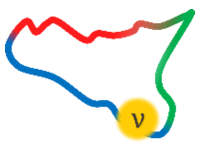Conveners
Oral contribution
- Horst Lenske
Oral contribution
- Livia Ludhova (Forschungzentrum Juelich IKP-2)
Oral contribution
- Chiara Brofferio (Istituto Nazionale di Fisica Nucleare)
Oral contribution
- Stefan Herbert Max Schoenert
Oral contribution
- Fedor Simkovic
Oral contribution
- Dimitra Pierroutsakou (Istituto Nazionale di Fisica Nucleare)
Oral contribution
- Maria Benedetta Barbaro (Istituto Nazionale di Fisica Nucleare)
Oral contribution
- Francesco Vissani (Istituto Nazionale di Fisica Nucleare)
Oral contribution
- Luciano Pandola (Istituto Nazionale di Fisica Nucleare)
Oral contribution
- Giovanni Marsella (Istituto Nazionale di Fisica Nucleare)
Oral contribution
- Michele Maltoni (Instituto de Fisica Teorica UAM/CSIC)
Neutrino mass ordering (NMO) is a fundamental problem that remains unresolved, with significant implications for interpreting the origin of neutrino mass, calculating the half-life of neutrinoless double-beta decay and understanding the cosmic structure formation. Current experimental approaches to determine NMO include: (1) Studying vacuum oscillations of reactor neutrinos; (2) Studying...
The coherent elastic neutrino-nucleus scattering (CEvNS) process is a promising approach for investigating neutrino properties and exploring physics beyond the Standard Model. The REactor neutrino LIquid xenon Coherent elastic Scattering experiment (RELICS) plans to deploy a 50-kilogram-scale two-phase liquid xenon time projection chamber (LXeTPC) near the reactor at China's Sanmen Nuclear...
Nuclear matrix elements (NMEs) are crucial for understanding weak interaction processes such as inverse beta decay (IBD) and neutrinoless double-beta decay (0νββ), which provide insights into neutrino properties and physics beyond the Standard Model. A novel experimental approach aims to extract NMEs using electromagnetic (EM) transitions from isobaric analog states (IAS). In this talk, I will...
The MONUMENT experiment aims to support nuclear matrix element calculations of neutrinoless double beta decay by investigating ordinary muon capture on double-beta daughter isotopes. These measurements were performed at the muon beamline of the Paul Scherrer Institute using a setup of high-purity germanium detectors and scintillator counters. The measured muon lifetimes can be compared to...
Nowadays, the search for neutrino-less double beta (0νββ) decay continues with undiminished interest since it is a prominent tool for probing neutrino nature and its absolute mass scale. However, the latter task is hampered by the puzzling inconsistencies in the calculations of the nuclear matrix elements (NMEs) of 0νββ decay [1], despite the existing experimental constraints. In this respect,...
The NUSES mission acts as a technological pathfinder, hosting a range of cutting-edge instruments for in-orbit detection of cosmic rays, neutrinos, and gamma rays across different energy ranges. Among these, the Terzina instrument stands out as a compact telescope featuring Schmidt-Cassegrain optics, specifically designed to observe Cherenkov radiation produced by Extensive Air Showers (EAS)...
The neutrinos from the core collapse SN1987A are the first extrasolar neutrinos to be ever detected and have been widely studied to infer the thermodynamical and temporal features of a supernova; however their interpretation in terms of the astrophysical properties of the explosion has been giving rise to heated debates since ever. At date, models are still under construction and simulations...
In Type-II seesaw model, an electroweak triplet scalar field $\Delta$ with a non-zero vacuum expectation value (vev) $v_\Delta$ is introduced to facilitate the generation of small neutrino masses. A non-zero $v_\Delta$ also affects the W mass through the electroweak $\rho$ parameter, making it to be less than 1 as predicted by standard model (SM). The component fields in $\Delta$ come along...
We investigate the atomic exchange effect between the bound electrons of the final atom and those emitted in the allowed $\beta$ decay of the parent nucleus. Electron wave functions are computed using the self-consistent Dirac–Hartree–Fock–Slater method, with orthogonality between continuum and bound states of the final atom enforced by modifying the last iteration of the self-consistent...

